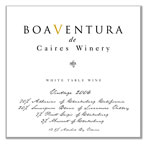 |
|
Wine Details
Price:
$20.00 per bottle
Description:
Our premier white wine release is a well-balanced, light wine made from 70% Clarksburg Albarino grapes, 20% Livermore Valley Sauvignon Blanc, and an added touch of Pinot Grigio and Muscat. Fermented in stainless-steel barrels (rather than wood), this very unique vintage has the crisp structure of a Pinot Grigio and explodes with aromas of peach and mango. The clean, vibrant flavor wakes up the palate and makes this wine the perfect accompaniment to seafood.
|
|
|